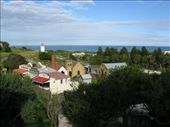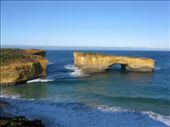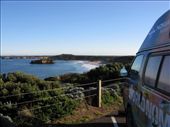As the road south from the climbing and trekking Mecca of
Grampians National Park spilled out onto the ocean a few hours later, we knew
our World Nomads Ambassador adventure was coming to an end. But it wasn’t a sad
moment, because we plan to go out with a bang!
 Australia’s
Great Ocean
road meanders from Warnambool on the western end to Melbourne
in the east. In the next few days we would see an array of spectacular vistas
covering the gambit from raging ocean on eroded limestone cliffs, to serene
fishing villages, to surfing towns with the merchandise and awesome off-shore
breaks to prove it. Although you can technically drive Great
Ocean Road in a day, you’d miss almost all of it
to stay on the winding road that some locals have dubbed the Great Bitumen Sea
Snake for all its twists and turns.
Australia’s
Great Ocean
road meanders from Warnambool on the western end to Melbourne
in the east. In the next few days we would see an array of spectacular vistas
covering the gambit from raging ocean on eroded limestone cliffs, to serene
fishing villages, to surfing towns with the merchandise and awesome off-shore
breaks to prove it. Although you can technically drive Great
Ocean Road in a day, you’d miss almost all of it
to stay on the winding road that some locals have dubbed the Great Bitumen Sea
Snake for all its twists and turns.
We were sure we saw other couples in passing cars doing
exactly what we were doing: gaping from the awesome scenery to the local
guidebook (Lonely Planet of course) and maps, then frantically pointing at the
nearest turn-off to snap a few hundred more picture-perfect moments.
were doing: gaping from the awesome scenery to the local
guidebook (Lonely Planet of course) and maps, then frantically pointing at the
nearest turn-off to snap a few hundred more picture-perfect moments.
 Interestingly though, there weren’t too many other couples
in other cars to identify with. Why, you ask? Well, characteristic of the drum
we march to that nobody else can figure out, we’re here in the off-season. Yes,
in the south of Australia,
the winter weather does not make for plentiful tourists.
Interestingly though, there weren’t too many other couples
in other cars to identify with. Why, you ask? Well, characteristic of the drum
we march to that nobody else can figure out, we’re here in the off-season. Yes,
in the south of Australia,
the winter weather does not make for plentiful tourists.
But we also like it that way thank you very much. Rolling
into towns such as Apollo Bay
is a treat when you can:
A) find parking
B) nab an ideal place to sit at the local waterfront café
C) take a picture of the scenery without a dozen wandering
people unwittingly getting in the shot.
Sure, we had to wear a few extra layers, and swimming was on
the very outer edge of possibility without hyperthermia kicking in after about
a minute. (We chose not to test that theory). But at least we had lots of
sunshine and none of the rain that is characteristic of the region at this time
of year.
outer edge of possibility without hyperthermia kicking in after about
a minute. (We chose not to test that theory). But at least we had lots of
sunshine and none of the rain that is characteristic of the region at this time
of year.
And sure, the towns didn’t quite have the life and energy
you’d feel if it was peak-season, but we actually got a chance to chat with the
locals more so than we might have otherwise.
While chatting with one such local shopkeeper in Apollo
Bay, we asked him about what it is
like to run a business in such a seasonal town.
 “It’s getting to be a year-round thing, slowly. We’re seeing
more and more tourists in the off-season, and the actual off-season is getting
shorter every year,” he said. “But for avoiding crowds, you’ve come at the
right time. We have a permanent population of 1,200 that swells up to 10,000 in
the summer.”
“It’s getting to be a year-round thing, slowly. We’re seeing
more and more tourists in the off-season, and the actual off-season is getting
shorter every year,” he said. “But for avoiding crowds, you’ve come at the
right time. We have a permanent population of 1,200 that swells up to 10,000 in
the summer.”
Great for business, bad for nature photography and hermits.
Another up-side to being here in the off-season is the price. Accommodation can double with the peak-season, along with (we suspect) the
prices at restaurants, cafes, and pretty much any establishment that relies on
tourism. This is the first area we have visited in our trip that has an obvious
dichotomy between off and peak-season rates, with no qualms about it.
Accommodation can double with the peak-season, along with (we suspect) the
prices at restaurants, cafes, and pretty much any establishment that relies on
tourism. This is the first area we have visited in our trip that has an obvious
dichotomy between off and peak-season rates, with no qualms about it.
Then again, now that we are firmly planted on the very
southern coast of Australia,
the difference between summer and winter weather is more prevalent. I can only
imagine how glorious the Great Ocean Road
would be at the height of summer in comparison to its temperate-but-blustery
opposite.
Be that as it may, any visitor to the south of Australia
should not miss the Great Ocean Road,
no matter what time of year it is. Lonely Planet was right when they tell you
to wind down the windows while driving this stretch of road to enjoy the
“unique perfume of bush and beach, gums and saltwater.” In many ways, our
journey along the Great Ocean Road
is a combination and culmination of many of the adventures of our last six
weeks in the World Nomads Ambassador van.
the Great Ocean Road,
no matter what time of year it is. Lonely Planet was right when they tell you
to wind down the windows while driving this stretch of road to enjoy the
“unique perfume of bush and beach, gums and saltwater.” In many ways, our
journey along the Great Ocean Road
is a combination and culmination of many of the adventures of our last six
weeks in the World Nomads Ambassador van.